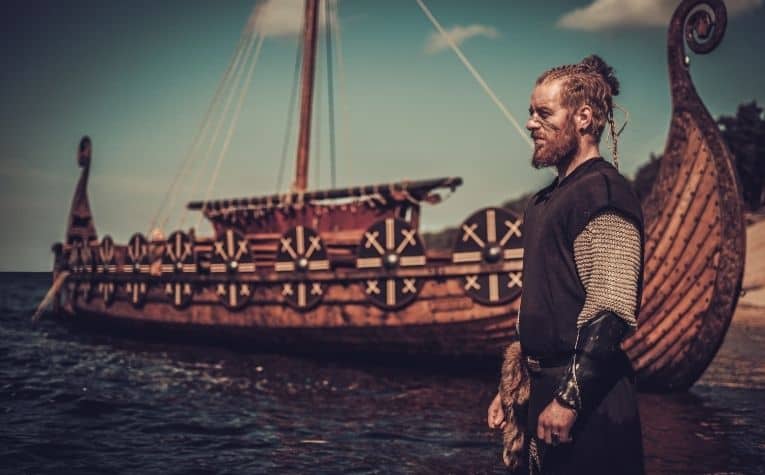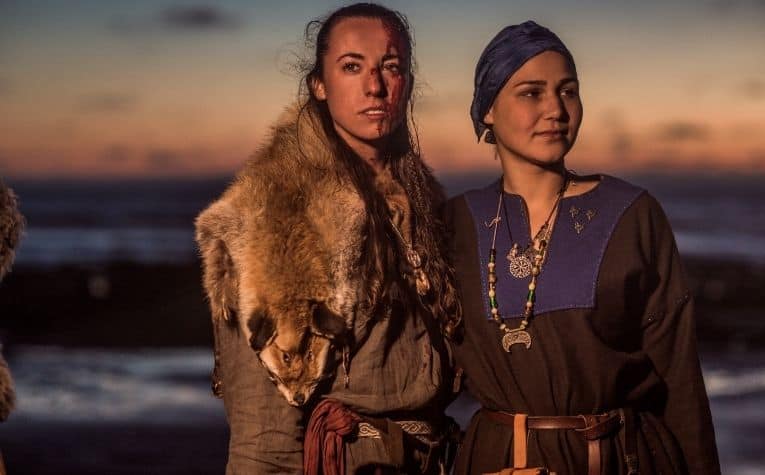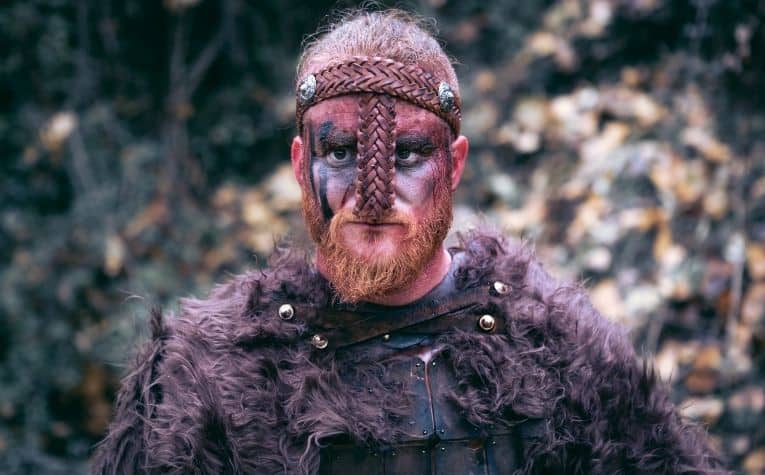Viking warriors were larger-than-life figures whose very appearance instilled fear in those who stood between them and their bounty.
They were masterful at intimidation and were not shy about making their intentions known.
There was also a unique sense of Nordic flair in the way they dressed and carried themselves, but when it came to body modification, the Vikings were surprisingly gentle.
Scholars and historians theorize that contrary to popular belief, the Vikings were actually fashion-conscious and expressed themselves through their appearance.
It is likely that some even had tattoos, but there is no evidence indicating that they wore earrings or had body piercings of any type.
Although the Vikings did not maintain a written history, relying instead on oral traditions, much has been learned about their culture through extensive research, physical evidence, and works that were written after the Viking Age ended.
Theirs was a structured yet free society that allowed many forms of self-expression, but surprisingly the Vikings did not seem to embrace body piercings, ears, or otherwise.
Are you curious about what the Vikings looked like? See What Did the Vikings Look Like? to learn what scientists believe about what their faces, hairstyles, clothing, skin color, and more.

Did Vikings Have Piercings of any Type?
Much of what is known about the Vikings has been pieced together from archaeological finds through the centuries, with certain gaps filled in by texts and poems that were written about them (most of which came many years after the end of the Viking Age).
It is through this admittedly imperfect lens that certain aspects of Viking life have been re-constructed.
For instance, what is beyond dispute is that the Vikings wore different forms of jewelry and for various purposes.
Excavations of Norse graves and settlements have revealed the types of adornments and trinkets favored by the Vikings, but equally telling as far as their preferences for fashion accessories go is the lack of earrings and other body piercing implements that have been recovered.
Aside from a few Slavic origin pieces believed to have been acquired through trade or plunder, earrings have been noticeably absent from Viking graves.
From this lack of physical evidence and the absence of written descriptions suggesting otherwise, it is apparent that the Vikings were not fond of earrings or other forms of body piercings for whatever reasons or unknown circumstances. [1] [2]
Norse sagas and poems are completely devoid of any descriptions of piercings involving:
- Ears
- Noses
- Septums
- Navels
- Any other body part
Outsider accounts of the Vikings and their appearance also fail to mention earrings or any other form of body piercings.
Still, they do go into detail about another form of body modification: elaborate tattoos covering their entire arms and the use of permanent eyeliner.
A lot of people wonder what the Vikings looked like. See The Vikings Dress Code: What They Wore and How to learn more.

The Vikings Were Fond of Jewelry
Although findings of earrings have been scant in excavations of Viking settlements and graves, other forms of jewelry have been recovered in significant numbers.
This can be attributed to the fact that Viking burial practices included burying their dead with implements they would need in the afterlife and items indicating their status or position in life.
These included:
- Weapons – Viking warriors were buried with their full complement of weapons, including swords, shields, armor, axes, knives, and arrows.
- Practical implements – items indicative of a person’s social status or standing in the community would be buried with them. Sometimes this even included ships, carriages, horses, and slaves.
- Coins and jewelry – these would be the primary indicator of the deceased’s wealth and social class and would be buried as part of the grave goods to ensure that they could carry on with the same level of comfort and luxury in the afterlife. [5]
Jewelry items that have been recovered among Viking artifacts were either plundered during raids on monasteries and other targets of opportunity or were crafted by the Vikings themselves after learning to appreciate the beauty and value of jewelry pieces.
As far as the forms of jewelry worn by the Vikings, these included:
- Necklaces, pendants, and amulets – among the types of jewelry known to have been worn by the Vikings are necklaces and neck rings (bands worn around the neck). Gold, silver, and bronze were common metals used to make these items, which were typically worn as a show of wealth.
The Vikings commonly adorned their necklaces with pendants and amulets for decorative, symbolic, and spiritual purposes.
Thor’s hammer, Mjolnir, was likely the most popular choice, with the Valknut (also known as Odin’s knot, consisting of three interlocking triangles) coming in a close second.
- Armbands and rings – the Vikings were fond of rings, whether worn on their fingers or their arms like bands. Made primarily from gold or silver, these forms of jewelry were often an indication of wealth and status.
- Brooches – unlike necklaces, rings, and armbands, brooches served a vital and practical purpose as a fastener for cloaks on men and dresses and aprons on women. Although first and foremost an everyday Viking clothing accessory, some brooches were ornately decorated. [6] [7]
Jewelry made from precious metals like gold and silver decorated with gemstones and crystals were worn exclusively by Viking society’s wealthier members. In contrast, the lower classes wore simpler items decorated with colored glass beads. [8]
Viking women payed a unique role in their society. See Did Female Vikings Go On Raids? to learn more.
Viking Jewelry was also Used as Currency

Even though the Vikings are thought to have worn jewelry for primarily ornamental purposes, scholars and historians also believe that items like necklaces, neck rings, arm rings, and the like also served a more practical purpose.
For the Vikings, the jewelry they wore also doubled as a form of currency to pay for transactions, such as in exchange for goods or as compensation for services.
This explains why most Viking jewelry was made from precious metals like gold, silver, and bronze.
The Vikings went so far as to cut off bits and pieces of particular sizes from their jewelry to correspond to a specific trade or exchange value.
Jewelry was considered an essential item to include among grave goods so that the deceased would have a form of currency for use in the afterlife. [9]
Why Didn’t the Vikings have Piercings?
As far as Viking warriors, it can be argued that wearing earrings and the like would have been ill-advised while engaged in combat or similar activities, as opportunistic enemy soldiers could inflict injury by grabbing hold of them.
By this same logic, Vikings would never have worn the stereotypical and historically inaccurate horned helmets into battle as they could become entangled in enemy gear.
Some Vikings were Tattooed
While they may have been hesitant to pierce themselves, some Vikings were not only tattooed but quite heavily covered in them by several historical accounts.
Viking longships traveled as far as Russia, Central Asia, and even the Middle East to engage in lucrative dealings for their Scandinavian fur and other goods.
As was sadly quite common for the era, they also engaged in slave trading.
See the full article: How Vikings Got Tattoos and Why to learn more.
In a bustling trade center in the Volga region of what is now Russia, Viking traders caught the eye of an Arabic scholar from Baghdad named Ahmad Ibn Fadlan.
Referring to them as the “Rusiyyah,” Ibn Fadlan was impressed by the Vikings’ “nearly perfect” bodies and was struck by greenish markings on their skin of trees and symbols that extended from their fingertips all the way to their necks. [3]
According to an account written by another Arabic traveler named al-Tartushi, while visiting the Danish Viking settlement known as Hedeby (located in modern-day Germany), it was noted that on their arms and chests, Viking men had tattoos of:
- Animals
- Trees
- Foreign symbols
That wasn’t the only ink they wore. They also wore what appeared to be permanent makeup around their eyes that gave them an attractive, youthful appearance. [4]
Conclusion
Hardly anything about the way that the Vikings lived and fought was unassuming subdued conventional, except perhaps, their unwillingness to pierce any part of their bodies.
References:
[1] en.natmus.dk
[2] skjalden.com
[3] ancient-origins.net
[4] ancientpages.com
[5] history.com
[6] ancient.ed
[7] norsespirit.com
[8] norse-mythology.org
[9] blog.vkngjewelry.com
